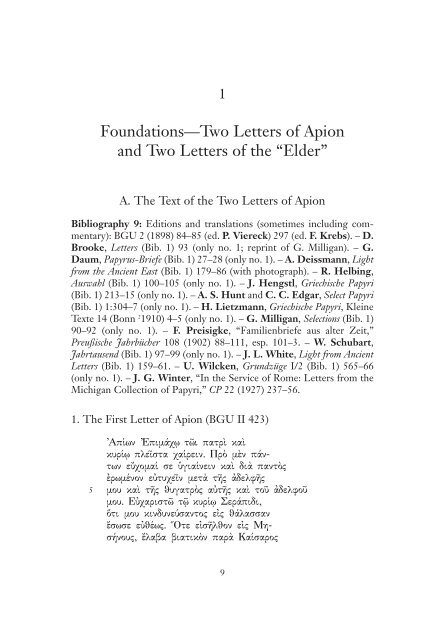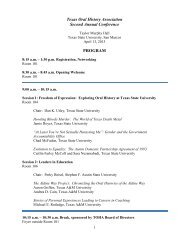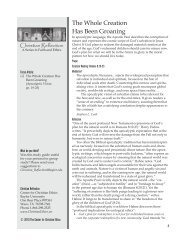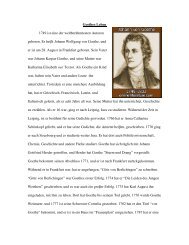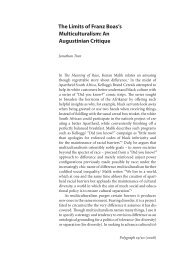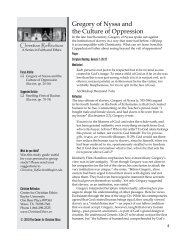Foundations—Two Letters of Apion and Two Letters of the “Elder”
Foundations—Two Letters of Apion and Two Letters of the “Elder”
Foundations—Two Letters of Apion and Two Letters of the “Elder”
Create successful ePaper yourself
Turn your PDF publications into a flip-book with our unique Google optimized e-Paper software.
A. The Text <strong>of</strong> <strong>the</strong> <strong>Two</strong> <strong>Letters</strong> <strong>of</strong> <strong>Apion</strong><br />
Bibliography 9: Editions <strong>and</strong> translations (sometimes including commentary):<br />
BGU 2 (1898) 84–85 (ed. P. Viereck) 297 (ed. F. Krebs). – D.<br />
Brooke, <strong>Letters</strong> (Bib. 1) 93 (only no. 1; reprint <strong>of</strong> G. Milligan). – G.<br />
Daum, Papyrus-Briefe (Bib. 1) 27–28 (only no. 1). – A. Deissmann, Light<br />
from <strong>the</strong> Ancient East (Bib. 1) 179–86 (with photograph). – R. Helbing,<br />
Auswahl (Bib. 1) 100–105 (only no. 1). – J. Hengstl, Griechische Papyri<br />
(Bib. 1) 213–15 (only no. 1). – A. S. Hunt <strong>and</strong> C. C. Edgar, Select Papyri<br />
(Bib. 1) 1:304–7 (only no. 1). – H. Lietzmann, Griechische Papyri, Kleine<br />
Texte 14 (Bonn 2 1910) 4–5 (only no. 1). – G. Milligan, Selections (Bib. 1)<br />
90–92 (only no. 1). – F. Preisigke, “Familienbriefe aus alter Zeit,”<br />
Preußische Jahrbücher 108 (1902) 88–111, esp. 101–3. – W. Schubart,<br />
Jahrtausend (Bib. 1) 97–99 (only no. 1). – J. L. White, Light from Ancient<br />
<strong>Letters</strong> (Bib. 1) 159–61. – U. Wilcken, Grundzüge I/2 (Bib. 1) 565–66<br />
(only no. 1). – J. G. Winter, “In <strong>the</strong> Service <strong>of</strong> Rome: <strong>Letters</strong> from <strong>the</strong><br />
Michigan Collection <strong>of</strong> Papyri,” CP 22 (1927) 237–56.<br />
1. The First Letter <strong>of</strong> <strong>Apion</strong> (BGU II 423)<br />
∆Apivwn ∆Epimavcw/ twì patri; kai;<br />
kurivw/ plei`sta caivrein. Pro; me;n pavntwn<br />
eu[comaiv se uJgiaivnein kai; dia; panto;~<br />
ejrwmevnon eujtucei`n meta; th`~ ajdelfh`~<br />
5 mou kai; th`~ qugatro;~ aujth`~ kai; tou` ajdelfou`<br />
mou. Eujcaristw` tw` / kurivw/ Seravpidi,<br />
o{ti mou kinduneuvsanto~ eij~ qavlassan<br />
e[swse eujqevw~. ”Ote eijsh`lqon eij~ Mhshvnou~,<br />
e[laba biatiko;n para; Kaivsaro~<br />
1<br />
<strong>Foundations—<strong>Two</strong></strong> <strong>Letters</strong> <strong>of</strong> <strong>Apion</strong><br />
<strong>and</strong> <strong>Two</strong> <strong>Letters</strong> <strong>of</strong> <strong>the</strong> <strong>“Elder”</strong><br />
9
10 <strong>Letters</strong> <strong>of</strong> <strong>Apion</strong> <strong>and</strong> <strong>Letters</strong> <strong>of</strong> <strong>the</strong> <strong>“Elder”</strong><br />
10 crusou`~ trei`~ kai; kalw`~ moiv ejstin.<br />
∆Erwtw` se ou`n, kuvriev mou pathvr,<br />
gravyon moi ejpistovlion prw`ton<br />
me;n peri; th`~ swthriva~ sou, deuvteron<br />
peri; th`~ tw`n ajdelfw`n mou,<br />
15 tr[iv]ton, i{na sou proskunhvsw th;n<br />
cevran, o{ti me ejpaivdeusa~ kalw`~<br />
kai; ejk touvtou ejlpivzw tacu; prokov(mi-)<br />
sai tw`n qe[w`]n qelovntwn. “Aspasai<br />
Kaipivtwn[a po]lla; kai; to[u;~] ajdelfouv~<br />
20 [m]ou kai; Se[rhniv]llan kai; to[u;~] fivlou~ mo[u].<br />
“Epemyav so[i e∆i]kovnin m[ou] dia; Eujkthvmono~.<br />
“Es[t]i [dev] mou o[noma ∆Antw`ni~ Mavximo~<br />
∆Errw`sqaiv se eu[comai.<br />
Kenturiv(a) ∆Aqhnonivkh.<br />
In <strong>the</strong> left margin, perpendicular to <strong>the</strong> main text (as addendum):<br />
25 ∆Aspavzetaiv se Serh`no~ oJ tou` ∆Agaqou` [Da]ivmono~ [kai; ....]~<br />
oJ tou` [...]<br />
ro~ kai; Touvrbwn oJ tou` Gallwnivou kai; D[....]na`~ oJ t[ou` .....]sen<br />
[. . .]<br />
[....]. [...]. [ ]<br />
Verso (outside address):<br />
e[ij~] F[il]adelfivan ∆Epim X avcw/ ajpo; ∆Apivwno~ uiJou`.<br />
In <strong>the</strong> opposite direction (additional address):<br />
∆Apovdo~ eij~ cwvrthn privman X ∆Apamhnw`n ∆Io[uli]av[n]ou ∆An.[..]<br />
30 liblarivw/ ajpo; ∆Apivwno~ w{s X te ∆Epimavcw/ patri; aujtou`.<br />
Translation (cf. J. L. White [modified]):<br />
<strong>Apion</strong> to Epimachos, his fa<strong>the</strong>r <strong>and</strong> | lord, very many greetings.<br />
Before | all else I pray that you are well <strong>and</strong> that | you may prosper<br />
in continual health, toge<strong>the</strong>r with my sister | [5] <strong>and</strong> her daughter <strong>and</strong><br />
my bro<strong>the</strong>r. |<br />
I give thanks to <strong>the</strong> lord Serapis, | because when I was endangered<br />
at sea, | he rescued (me) immediately.<br />
When I arrived at Mi- | senum, I received as traveling money<br />
(viaticum) from Caesar | [10] three gold pieces, <strong>and</strong> I am well.
Therefore, I request you, my lord fa<strong>the</strong>r, | write me a letter, first |<br />
about your welfare, se- | condly about <strong>the</strong> welfare <strong>of</strong> my siblings, | [15]<br />
thirdly, in order that I may make obeisance before your | h<strong>and</strong>(writing),<br />
because you trained me well, | <strong>and</strong> I hope by this means quickly to ad- |<br />
vance, <strong>the</strong> gods willing.<br />
Salute | Kapiton very much <strong>and</strong> my siblings | [20] <strong>and</strong> Serenilla <strong>and</strong><br />
my friends. | I sent my portrait to you through Eukte- | monos. My<br />
name is Antonius Ma- | ximus.<br />
I pray that you are well. |<br />
Company A<strong>the</strong>nonike. |<br />
In <strong>the</strong> left margin (addendum):<br />
[25] Serenos, <strong>the</strong> (son) <strong>of</strong> Agathodaimon, salutes you …, <strong>and</strong> …, <strong>the</strong><br />
(son) <strong>of</strong> | …ros, <strong>and</strong> Tourbon, <strong>the</strong> son <strong>of</strong> Gallonios, <strong>and</strong> D...nas, <strong>the</strong><br />
(son) <strong>of</strong> ….<br />
On <strong>the</strong> reverse (outside address):<br />
The Text <strong>of</strong> <strong>the</strong> <strong>Two</strong> <strong>Letters</strong> <strong>of</strong> <strong>Apion</strong> 11<br />
To Philadelphia, to Epimachos from (his) son, <strong>Apion</strong>.<br />
In <strong>the</strong> opposite direction (additional address):<br />
Deliver at <strong>the</strong> camp <strong>of</strong> <strong>the</strong> first cohort <strong>of</strong> <strong>the</strong> Apameni (cohors prima<br />
Apamenorum) to Julianus, vice-secretary (Gk. liblavrio~; Lat. libellarius),<br />
(this letter) from <strong>Apion</strong> so that (it might be forwarded) to his<br />
fa<strong>the</strong>r, Epimachos.<br />
The letter, which is dated to <strong>the</strong> second century CE on <strong>the</strong> basis<br />
<strong>of</strong> paleography, consists <strong>of</strong> only a single papyrus sheet. It was<br />
found where its recipient lived, in <strong>the</strong> Fayum, a region <strong>of</strong> Egypt<br />
west <strong>of</strong> <strong>the</strong> Lower Nile on one <strong>of</strong> its branches. This was also <strong>the</strong><br />
home <strong>of</strong> <strong>the</strong> letter’s author, a young man with <strong>the</strong> Egyptian name<br />
<strong>Apion</strong>, who writes to his fa<strong>the</strong>r Epimachos, addressing him<br />
respectfully as “lord.” <strong>Apion</strong> also has a sister, who in turn is <strong>the</strong><br />
mo<strong>the</strong>r <strong>of</strong> a daughter, <strong>and</strong> a bro<strong>the</strong>r, <strong>and</strong> he wishes his entire family<br />
health <strong>and</strong> well-being. In crossing <strong>the</strong> Mediterranean he fell<br />
into danger at sea <strong>and</strong> now thanks <strong>the</strong> Greco-Egyptian god Serapis,<br />
whom he refers to as kyrios or “lord” in keeping with <strong>the</strong> custom <strong>of</strong><br />
<strong>the</strong> time, to whom he presumably cried for help.<br />
Why did <strong>Apion</strong> take to <strong>the</strong> sea in <strong>the</strong> first place? While at<br />
home in Egypt he had let himself be recruited by Roman troops
12 <strong>Letters</strong> <strong>of</strong> <strong>Apion</strong> <strong>and</strong> <strong>Letters</strong> <strong>of</strong> <strong>the</strong> <strong>“Elder”</strong><br />
for <strong>the</strong> imperial fleet <strong>and</strong> was subsequently shipped <strong>of</strong>f to<br />
Misenum, a Roman military harbor on <strong>the</strong> Gulf <strong>of</strong> Naples. Having<br />
arrived <strong>the</strong>re he immediately received a viaticum <strong>of</strong> three gold<br />
pieces—a Latin term more or less appropriately transliterated into<br />
Greek as biatikovn in line 9 (Greek b was already beginning to be<br />
pronounced like <strong>the</strong> English letter “v” in <strong>the</strong> second century CE,<br />
as in Modern Greek). This refers to <strong>Apion</strong>’s money for travel <strong>and</strong><br />
maintenance, which he obviously did not receive directly from <strong>the</strong><br />
Roman emperor but from <strong>the</strong> bursar <strong>of</strong> <strong>the</strong> imperial regiment.<br />
Three gold pieces correspond to 75 drachmas, equivalent to two<br />
or three months <strong>of</strong> ordinary wages—no wonder <strong>Apion</strong> expresses<br />
contentment with his situation.<br />
<strong>Apion</strong> now asks his “lord fa<strong>the</strong>r” for a short letter (ejpistovlion)<br />
from home with news <strong>of</strong> his fa<strong>the</strong>r’s health (swthriva) <strong>and</strong><br />
that <strong>of</strong> his siblings (<strong>the</strong> generic plural tw`n ajdelfw`n in line 14<br />
refers to both <strong>the</strong> sister <strong>and</strong> bro<strong>the</strong>r <strong>of</strong> ll. 4–5). Fur<strong>the</strong>rmore, he<br />
wants <strong>the</strong> opportunity <strong>of</strong> “making obeisance” to his fa<strong>the</strong>r’s h<strong>and</strong>writing,<br />
which he could do, for example, by drawing <strong>the</strong> letter to<br />
his lips for a kiss (<strong>the</strong> verb in l. 15, proskunevw, can mean ei<strong>the</strong>r<br />
to make obeisance or to kiss). He <strong>the</strong>reby expresses his thanks<br />
once again that his fa<strong>the</strong>r has raised him so well <strong>and</strong> that he can,<br />
for example, read <strong>and</strong> write (even though he need not have written<br />
this letter with his own h<strong>and</strong>: see <strong>the</strong> text below, with n. 3).<br />
This will st<strong>and</strong> him in good stead in his future career in <strong>the</strong><br />
Roman navy, subject to <strong>the</strong> gracious approval <strong>of</strong> <strong>the</strong> gods (<strong>the</strong><br />
phrase “if <strong>the</strong> Lord wills” also occurs in James 4:15 <strong>and</strong> is <strong>the</strong>refore<br />
designated <strong>the</strong> conditio Jacobea). The fa<strong>the</strong>r is also asked to<br />
pass on fur<strong>the</strong>r greetings, first to a man by <strong>the</strong> name <strong>of</strong> Kapiton,<br />
secondly to <strong>the</strong> ajdelfouv~, which probably refers here in line 19<br />
as in line 14 to <strong>the</strong> sister <strong>and</strong> bro<strong>the</strong>r <strong>of</strong> lines 4–5—thus designating<br />
not “bro<strong>the</strong>rs” but more precisely “siblings.” This also<br />
implies that <strong>the</strong> next person to be greeted, Serenilla, cannot be<br />
<strong>the</strong> sister <strong>of</strong> <strong>the</strong> writer, who happens to have <strong>the</strong> name Sabina as<br />
we learn from <strong>the</strong> second letter, but is ra<strong>the</strong>r one <strong>of</strong> <strong>the</strong> “friends”<br />
mentioned in summary at <strong>the</strong> end.<br />
Before his concluding wish for his fa<strong>the</strong>r’s well-being, <strong>Apion</strong><br />
quickly adds two fur<strong>the</strong>r pieces <strong>of</strong> information. Depending on <strong>the</strong><br />
interpretation <strong>of</strong> <strong>the</strong> verb e[pemya, he ei<strong>the</strong>r informs his fa<strong>the</strong>r<br />
that he has previously “sent” him something through his country-
The Text <strong>of</strong> <strong>the</strong> <strong>Two</strong> <strong>Letters</strong> <strong>of</strong> <strong>Apion</strong> 13<br />
man Euktemonos or, if e[pemya is an epistolary aorist (i.e., representing<br />
past time only for <strong>the</strong> letter recipient, but present time for<br />
<strong>the</strong> writer), that he is now sending his fa<strong>the</strong>r something extra, but<br />
separately from this letter, namely through Euktemonos. The<br />
item that Euktemonos is to deliver personally (which is too private<br />
to be conveyed by <strong>the</strong> military post) is a portrait, quickly sketched<br />
by a pr<strong>of</strong>essional painter on a sheet <strong>of</strong> papyrus, that in all probability<br />
portrays <strong>Apion</strong> in his military uniform. <strong>Apion</strong> has also taken<br />
on a Roman name, Antonius Maximus. This had no legal force,<br />
since Roman citizenship was not granted to soldiers <strong>of</strong> <strong>the</strong> fleet<br />
until <strong>the</strong> end <strong>of</strong> <strong>the</strong>ir service at <strong>the</strong> earliest. But it was very useful<br />
for <strong>Apion</strong>’s fa<strong>the</strong>r to know his new name so that he could correctly<br />
address his response letter, <strong>and</strong> for this purpose <strong>Apion</strong> also includes<br />
his military unit, Kenturiva ∆Aqhnonivkh or Company A<strong>the</strong>nonike<br />
(l. 24). Analogously to <strong>the</strong> l<strong>and</strong> forces, where a company or “century”<br />
means a hundred men as a military unit, <strong>the</strong> term kenturiva<br />
is used in this case to designate <strong>the</strong> warship, which bears <strong>the</strong> proud<br />
name A<strong>the</strong>nonike, “A<strong>the</strong>na as Victor” or “Victory in <strong>the</strong> Name <strong>of</strong><br />
A<strong>the</strong>na,” <strong>the</strong> Greek goddess.<br />
Nor is this enough. In <strong>the</strong> left margin several o<strong>the</strong>r young men<br />
send <strong>the</strong>ir greetings, only two <strong>of</strong> whose names, Serenos <strong>and</strong><br />
Tourbon, we can decipher with certainty. It is striking that <strong>the</strong><br />
fa<strong>the</strong>rs’ names are always given toge<strong>the</strong>r with those <strong>of</strong> <strong>the</strong>ir sons.<br />
This has <strong>the</strong> following background: Along with <strong>Apion</strong>, o<strong>the</strong>r comrades<br />
<strong>and</strong> members <strong>of</strong> his age group from his area reported to <strong>the</strong><br />
military <strong>and</strong> now find <strong>the</strong>mselves in <strong>Apion</strong>’s proximity. Their<br />
fa<strong>the</strong>rs are named so that <strong>the</strong>re will be no confusion when <strong>the</strong>ir<br />
greetings are forwarded in <strong>the</strong>ir home area.<br />
All this is found on <strong>the</strong> front <strong>of</strong> <strong>the</strong> papyrus sheet. On <strong>the</strong> back,<br />
which is turned to <strong>the</strong> outside when <strong>the</strong> papyrus is folded, st<strong>and</strong>s<br />
<strong>the</strong> first outside address, included when <strong>the</strong> letter was written: to<br />
<strong>the</strong> little village <strong>of</strong> Philadelphia in <strong>the</strong> Fayum (also known as <strong>the</strong><br />
district <strong>of</strong> Arsinoe or <strong>the</strong> Arsinoite nome) from <strong>Apion</strong>, <strong>the</strong> son, to<br />
Epimachos, his fa<strong>the</strong>r. The letter X as printed above in <strong>the</strong> Greek<br />
text <strong>of</strong> <strong>the</strong> outside address is an academic convention to mark <strong>the</strong><br />
place where <strong>the</strong> string <strong>of</strong> papyrus fibers used to tie <strong>the</strong> folded<br />
papyrus cuts through <strong>the</strong> letters. Also on <strong>the</strong> outside, but written in<br />
<strong>the</strong> opposite direction, is an additional address, presumably added<br />
not by <strong>Apion</strong> but by <strong>the</strong> secretarial <strong>of</strong>fice <strong>of</strong> <strong>the</strong> garrison in
14 <strong>Letters</strong> <strong>of</strong> <strong>Apion</strong> <strong>and</strong> <strong>Letters</strong> <strong>of</strong> <strong>the</strong> <strong>“Elder”</strong><br />
Misenum. The letter is to be carried by military post to <strong>the</strong> first<br />
cohort <strong>of</strong> <strong>the</strong> Apameni (cohors prima Apamenorum), which was in<br />
fact stationed in Egypt at this time, where it is to be received by a<br />
certain Julianus, 1 whose Greek title as a liblavrio~ is perhaps a<br />
transliteration not <strong>of</strong> <strong>the</strong> Latin librarius, as <strong>of</strong>ten maintained, but <strong>of</strong><br />
libellarius (or pro libellario if we read ajntiv instead <strong>of</strong> ∆An[…]). 2 Ei<strong>the</strong>r<br />
way it designates Julianus as a secretary or military archivist.<br />
1 The case-ending -ou <strong>of</strong> Julianus’s name in <strong>the</strong> second outside<br />
address, ∆Apovdo~ . . . ∆Iouliavnou liblarivw/, requires comment. If taken<br />
as genitive, as it first appears, <strong>the</strong> text would mention two people, one<br />
named, <strong>the</strong> o<strong>the</strong>r not: “<strong>the</strong> liblavrio~ <strong>of</strong> Julianus.” Julianus would <strong>the</strong>n be<br />
<strong>the</strong> comm<strong>and</strong>er <strong>of</strong> <strong>the</strong> cohort <strong>of</strong> <strong>the</strong> Apameni, <strong>and</strong> <strong>Apion</strong>’s letter would be<br />
delivered to Julianus’s secretary to be forwarded to Epimachos. But none<br />
<strong>of</strong> <strong>the</strong> scholars in Bib. 9 unequivocally favors this reading; Daum (72)<br />
mentions it only as a possibility. Most translators, including Deissmann,<br />
Hengstl, Hunt <strong>and</strong> Edgar, Milligan, <strong>and</strong> White, believe that Julianus himself<br />
is <strong>the</strong> liblavrio~ <strong>and</strong> that <strong>the</strong> construction is an apposition, more regularly<br />
written as ∆Iouliavnw/ liblarivw/ (for <strong>the</strong> form ∆Iouliavnw/, cf. P.Oxy.<br />
III 488.1 [II or III CE]). Here ∆Iouliavnou serves as <strong>the</strong> dative instead <strong>of</strong><br />
∆Iouliavnw/, but <strong>the</strong> difference <strong>of</strong> form implies no difference <strong>of</strong> meaning.<br />
For as F. T. Gignac writes about <strong>the</strong> case-endings <strong>of</strong> second declension<br />
nouns in <strong>the</strong> papyri <strong>of</strong> this period, “Fluctuation between -ou <strong>and</strong> -w(i) in<br />
<strong>the</strong> gen. <strong>and</strong> dat. sg. cannot be considered significant for morphology. It<br />
is caused partly by <strong>the</strong> confusion <strong>of</strong> -ou for -w(i) in <strong>the</strong> speech <strong>of</strong> some<br />
writers <strong>and</strong> partly by a syntactic confusion <strong>of</strong> <strong>the</strong> gen. <strong>and</strong> dat. cases”<br />
(Grammar <strong>of</strong> <strong>the</strong> Greek Papyri <strong>of</strong> <strong>the</strong> Roman <strong>and</strong> Byzantine Periods, vol. 2:<br />
Morphology [Milan 1981] 22).<br />
2 For <strong>the</strong> opposite view, preferring librarius over libellarius, see<br />
Deissmann, Light, 182 n. 26. The linguistic data can be argued ei<strong>the</strong>r way.<br />
In favor <strong>of</strong> liblavrio~ = libellarius is <strong>the</strong> fact that librarius is elsewhere<br />
transliterated more straightforwardly as libravrio~, e.g., Bulletin de Correspondence<br />
Hellénique 7.275 (II CE) (cited by both Barber <strong>and</strong> Glare), leaving<br />
liblavrio~ to be traced to a different Latin term. This seems to be <strong>the</strong><br />
opinion <strong>of</strong> <strong>the</strong> revised LSJ supplement, for <strong>the</strong> equation or cross-reference<br />
<strong>of</strong> libravrio~ with “cf. liblavrio~” in <strong>the</strong> original Supplement by E. A.<br />
Barber (1968) 93, s.v. libravrio~ has since been removed in <strong>the</strong> Greek-<br />
English Lexicon: Revised Supplement by P. G. W. Glare (Oxford 1996) 196,<br />
s.v. libravrio~. On <strong>the</strong> o<strong>the</strong>r h<strong>and</strong>, <strong>the</strong> same -bl- instead <strong>of</strong> -br- spelling<br />
that might o<strong>the</strong>rwise be thought to favor libellarius is taken by Gignac as<br />
evidence <strong>of</strong> <strong>the</strong> opposite in his analysis <strong>of</strong> leiblavrei~ = librarius in P.Oxy.<br />
I 43 R v. 19 (295 CE) (Gignac, Grammar 2:27).
2. The Second Letter <strong>of</strong> <strong>Apion</strong> (BGU II 632)<br />
Verso:<br />
∆An[twvni]o~ Mavximo~ Sabivnh/<br />
th`/ ajdelfh`/ plei`sta caivrein.<br />
Pro; me;n pavntwn eu[comaiv<br />
se uJgiaivnein, kai; ∆gw ga;r aujto;~<br />
5 uJgiaivn[w]. Mnivan soi poiouvmeno~<br />
para; toi`~ [ejn]qavde qeoi`~<br />
ejkomisavmhn [e}]n ejpi[s]tovlion<br />
para; ∆Antwne[iv]nou tou` sunpol[e]ivtou<br />
hJmw`n. Kai; ejpignouv~<br />
10 se ejrrwmevnhn livan ejcavrhn.<br />
Kai; ∆gw dia; pa`san ajformh;n<br />
o[uj]c ojknw` soi gravyai peri;<br />
th`[~] swthriva~ mou kai; tw`n<br />
ejmw`n. “Aspasai Mavximon<br />
15 polla; kai; Koprh;n to;n kuvrin<br />
m[ou. ∆A]spavzetaiv se hJ suvmbiov~<br />
[mou A]ujfidiva kai; Mavximo~<br />
[oJ uiJov~ m]ou, [ou|] ejsti[n] ta; genev-<br />
[sia ∆E]peip triaka;~ kaq∆ ”El-<br />
20 [lhna]~, kai; ∆Elpi;~ kai; Fortou-<br />
[na`ta]. “Asp[a]sai to;n kuvrion<br />
– Six fur<strong>the</strong>r lines are destroyed –<br />
28 [ejrrw`sqaiv se eu[co]mai.<br />
Translation:<br />
The Text <strong>of</strong> <strong>the</strong> <strong>Two</strong> <strong>Letters</strong> <strong>of</strong> <strong>Apion</strong> 15<br />
[Sabivnh/] aj[de]lf[h` /] ajp[o;] ∆Ant[w]nivou Maxivm[o]u ajdel[fou`.]<br />
Antonius Maximus to Sabina, | his sister, very many greetings.<br />
Before all else I pray | that you are well, for I myself | [5] am well.<br />
While making mention <strong>of</strong> you | before <strong>the</strong> gods here, | I received a<br />
letter from Antonius our fellow- | citizen. And when I learned that | [10]<br />
you are well, I rejoiced exceedingly. | And I, at every opportunity, | do not<br />
hesitate to write to you about | my welfare <strong>and</strong> (that) <strong>of</strong> | my family.<br />
Greet Maximus | [15] much <strong>and</strong> Kopres, my lord. | My wife (life<br />
partner: hJ suvmbio~), | Aufidia, greets you <strong>and</strong> so does Maximus, | my<br />
son, whose birth- | day is <strong>the</strong> thirtieth <strong>of</strong> Epeiph according to <strong>the</strong> Greek<br />
(calendar), | [20] as well as Elpis <strong>and</strong> Fortu- | nata. Greet my lord<br />
[six mutilated lines, 22–27, probably containing additional greetings]<br />
[28] I pray that you may be well.
16 <strong>Letters</strong> <strong>of</strong> <strong>Apion</strong> <strong>and</strong> <strong>Letters</strong> <strong>of</strong> <strong>the</strong> <strong>“Elder”</strong><br />
Verso (outside address):<br />
To Sabina, (his) sister, from (her) bro<strong>the</strong>r Antonius Maximus.<br />
The h<strong>and</strong>writing <strong>of</strong> <strong>the</strong> second letter looks different from that <strong>of</strong><br />
<strong>the</strong> first, 3 which could point to <strong>the</strong> use <strong>of</strong> a paid scribe in at least<br />
one <strong>of</strong> <strong>the</strong> two instances. Never<strong>the</strong>less, <strong>the</strong> names <strong>and</strong> content<br />
allow us to assume one <strong>and</strong> <strong>the</strong> same sender for both letters. The<br />
fa<strong>the</strong>r <strong>and</strong> niece from <strong>the</strong> first letter seem to have died in <strong>the</strong><br />
meantime, since <strong>the</strong>y are no longer mentioned. <strong>Apion</strong> now introduces<br />
himself from <strong>the</strong> beginning with his Roman name Antonius<br />
Maximus <strong>and</strong> addresses himself directly to his sister Sabina. He<br />
undergirds his health wish to her with a report <strong>of</strong> his own health.<br />
Without hesitation he can turn to oiJ ejnqavde qeoiv, “<strong>the</strong> gods here”<br />
(i.e., <strong>the</strong> favorite local gods <strong>of</strong> his current post), when he wants to<br />
remember his sister in prayer. A brief letter that Antonius<br />
Maximus has received from ano<strong>the</strong>r Egyptian named Antonius<br />
reporting that all is well at home gives him an occasion for joy <strong>and</strong><br />
an opportunity once again to report home with a few lines.<br />
Beyond this <strong>the</strong> letter lacks any real content, so that it serves<br />
in <strong>the</strong> first instance to maintain communication <strong>and</strong> give Antonius<br />
Maximus reassurance, since <strong>the</strong> greetings begin already in line 14.<br />
Maximus will be a nephew named after Antonius Maximus <strong>and</strong> <strong>the</strong><br />
“lord” Kopres will be his fa<strong>the</strong>r, Sabina’s husb<strong>and</strong>. <strong>Apion</strong>—or<br />
ra<strong>the</strong>r, Antonius Maximus—now has a wife or consort (suvmbio~ in<br />
ll. 16–17) by <strong>the</strong> name <strong>of</strong> Aufidia, a son, also named Maximus, who<br />
was both on June 24 (i.e., Epeiph 30 on <strong>the</strong> Greek calendar), <strong>and</strong><br />
two daughters with <strong>the</strong> expressive names Elpis (“Hope”) <strong>and</strong><br />
Fortunata (“Fortunate”).<br />
The rest <strong>of</strong> <strong>the</strong> greetings, which once filled six lines, are<br />
unreadable, <strong>and</strong> <strong>the</strong> wish for well-being at <strong>the</strong> end in line 28 is easier<br />
to guess than to recognize. This time an uncomplicated address<br />
on <strong>the</strong> verso suffices, which could speak for <strong>the</strong> conjecture that<br />
Antonius Maximus is currently stationed with his regiment in<br />
3 F. Krebs’s comment on this letter in <strong>the</strong> original publication, BGU<br />
2:297, “by <strong>the</strong> same h<strong>and</strong> as no. 423” (i.e., <strong>the</strong> first letter), does not seem<br />
to me to be above all suspicion; cf. also Winter 239 on <strong>the</strong> first letter:<br />
“Whe<strong>the</strong>r <strong>Apion</strong> wrote his own letter or not is not known, but <strong>the</strong> probability<br />
is that he dictated it to a letter-writer.”
St<strong>and</strong>ard Letter Components 17<br />
Alex<strong>and</strong>ria <strong>and</strong> <strong>the</strong>refore has more opportunity to write <strong>and</strong><br />
receive letters.<br />
It is not without good reason that A. Deissmann commented<br />
on this second letter:<br />
Written in a perfectly familiar strain, simply to impart family news<br />
<strong>and</strong> to convey all sorts <strong>of</strong> greetings, it never<strong>the</strong>less, like that o<strong>the</strong>r<br />
letter <strong>of</strong> richer content to <strong>the</strong> fa<strong>the</strong>r, gives us a glimpse <strong>of</strong> <strong>the</strong> close<br />
net <strong>of</strong> human relationships, o<strong>the</strong>rwise invisible, which <strong>the</strong> giant<br />
h<strong>and</strong>s <strong>of</strong> <strong>the</strong> Roman army <strong>and</strong> navy had woven with thous<strong>and</strong>s <strong>of</strong><br />
fine, strong threads <strong>and</strong> spread from coast to coast <strong>and</strong> from l<strong>and</strong> to<br />
l<strong>and</strong> over <strong>the</strong> enormous extent <strong>of</strong> <strong>the</strong> Mediterranean world at <strong>the</strong><br />
time <strong>of</strong> <strong>the</strong> infancy <strong>of</strong> Christianity. (Light from <strong>the</strong> Ancient East, 186)<br />
B. St<strong>and</strong>ard Letter Components<br />
Bibliography 10: P. Arzt, “‘Ich danke meinem Gott allezeit . . .’: Zur<br />
sogenannten ‘Danksagung’ bei Paulus auf dem Hintergrund griechischer<br />
Papyrusbriefe,” in F. V. Reiterer, ed., Ein Gott—eine Offenbarung: Beiträge<br />
zur biblischen Exegese und Spiritualität, FS N. Füglister (Würzburg 1991)<br />
417–37. – idem, “The ‘Epistolary Introductory Thanksgiving’ in <strong>the</strong><br />
Papyri <strong>and</strong> in Paul,” NovT 36 (1994) 29–46. – idem, Philemon (Bib. 4). –<br />
D. E. Aune, Dictionary (Bib. 4), s.v. “Epistolography,” 162–68, esp.<br />
166–67; “<strong>Letters</strong>, literary genre <strong>of</strong>,” 268–72; “Prescriptions, epistolary,”<br />
372. – P. Cugusi, Evoluzione (Bib. 2) 43–72. – F. X. J. Exler, The Form <strong>of</strong><br />
<strong>the</strong> Ancient Greek Letter (Bib. 2). – G. Geraci, “Ricerche sul Proskynema,”<br />
Aegyptus 51 (1971) 3–211. – G. A. Gerhard, “Untersuchungen zur<br />
Geschichte des griechischen Briefes I. Die Formel oJ dei`na tw` / dei`ni<br />
caivrein,” Philologus 64 (1905) 27–65. – M. van den Hout, Studies (Bib. 2).<br />
– T. Y. Mullins (all titles from Bib. 4). – B. Olsson, Papyrusbriefe (Bib. 2).<br />
– J. T. Reed, “Are Paul’s Thanksgivings ‘Epistolary’?” JSNT 61 (1996)<br />
87-99. – G. Tibiletti, Le lettere private (Bib. 2) 28–74. – J. A. D. Weima,<br />
Neglected Endings (Bib. 4) 28–56. – J. L. White, The Form <strong>and</strong> Function <strong>of</strong><br />
<strong>the</strong> Body <strong>of</strong> <strong>the</strong> Greek Letter (Bib. 2). – idem, The Greek Documentary Letter<br />
Tradition (Bib. 2). – idem, Ancient Greek <strong>Letters</strong> (Bib. 2).<br />
1. Letter Opening<br />
a) Letter Prescript<br />
The clearest sign that we have a letter before us is its so-called prescript,<br />
which—not to be confused with <strong>the</strong> outside address—opens
18 <strong>Letters</strong> <strong>of</strong> <strong>Apion</strong> <strong>and</strong> <strong>Letters</strong> <strong>of</strong> <strong>the</strong> <strong>“Elder”</strong><br />
<strong>the</strong> letter text on <strong>the</strong> inside. Its basic tripartite format is easy to<br />
recognize in <strong>the</strong> two <strong>Apion</strong> letters:<br />
(1) <strong>Apion</strong> superscriptio or superscription, sender’s<br />
or Antonius Maximus name in <strong>the</strong> nominative<br />
(2) to Epimachos adscriptio or adscription, addressee’s<br />
or Sabina name in <strong>the</strong> dative<br />
(3) Greetings! salutatio or salutation, greeting in <strong>the</strong><br />
infinitive (caivrein)<br />
Syntactically <strong>the</strong>se three elements form a single sentence.<br />
However, while typical <strong>of</strong> letters, it is unusual for Greek sentences<br />
at large to have <strong>the</strong> initial nominative followed not by a finite verb<br />
form such as <strong>the</strong> imperative cai`re (“Greetings!” or “Be greeted!”),<br />
but ra<strong>the</strong>r by a greeting expressed in <strong>the</strong> infinitive, here caivrein.<br />
Even <strong>the</strong> ancient grammarians racked <strong>the</strong>ir brains over this (cf.<br />
Gerhard). Fortunately, <strong>the</strong>re is a solution to <strong>the</strong> infinitive problem<br />
that also explains <strong>the</strong> use <strong>of</strong> <strong>the</strong> third person for both sender <strong>and</strong><br />
recipient as well as <strong>the</strong> sense <strong>of</strong> <strong>the</strong> verb caivrw in <strong>the</strong> light <strong>of</strong> its<br />
st<strong>and</strong>ard meaning “to rejoice.” This solution presupposes an older<br />
oral messenger formula (so also Gerhard 55, who draws on <strong>the</strong><br />
messenger formulas <strong>of</strong> <strong>the</strong> Old Testament for comparison). The<br />
messenger arrives on <strong>the</strong> scene <strong>and</strong> says: tavde levgei, “Thus says<br />
A to B, etc.” In direct discourse <strong>the</strong> end <strong>of</strong> this formula can indeed<br />
be completed by <strong>the</strong> imperative cai`re, “rejoice!” But in indirect<br />
discourse <strong>the</strong> infinitive caivrein is used, which leads to <strong>the</strong> statement,<br />
“A tells (levgei) B to rejoice (caivrein)” 4 or also “to feel<br />
greeted.” The verb levgei falls away when <strong>the</strong> oral usage is reduced<br />
to writing, <strong>and</strong> <strong>the</strong> resulting letter opening is left with an ellipse<br />
with merely caivrein. For <strong>the</strong> outside address writers used ano<strong>the</strong>r<br />
formula, which can also open <strong>of</strong>ficial petitions on <strong>the</strong> inside <strong>of</strong> <strong>the</strong><br />
letter, where it expresses <strong>the</strong> sender’s subordination to <strong>the</strong> recipient:<br />
“To B (dat.) from (ajpov, parav) A.” The missing verb in this<br />
4 Plato, or <strong>the</strong> pseudonymous author writing in his name, underst<strong>and</strong>s<br />
<strong>the</strong> st<strong>and</strong>ard greeting caivrein in this original sense “to rejoice”<br />
<strong>and</strong> <strong>the</strong>refore rejects it as a proper greeting for ei<strong>the</strong>r God or humans; cf.<br />
Ep. 3 at 315b–c <strong>and</strong> below, n. 8. See now also P. Arzt-Grabner, Philemon<br />
(Bib. 4) 109–11 <strong>and</strong> R. Wachter, “Griechisch cai`re: Vorgeschichte eines<br />
Grusswortes,” MH 55 (1998) 65–75.
St<strong>and</strong>ard Letter Components 19<br />
formula can be supplied mentally or, as in <strong>the</strong> case <strong>of</strong> <strong>the</strong> additional<br />
address <strong>of</strong> <strong>Apion</strong>’s first letter, <strong>the</strong> verb ajpovdo~ can be supplied<br />
directly, “Give [this] to B” (e.g., ∆Epimavcw/).<br />
This derivation <strong>of</strong> <strong>the</strong> infinitive caivrein (<strong>and</strong> uJgiaivnein) can<br />
still be readily retraced in a text from <strong>the</strong> fourth century BCE<br />
engraved on both sides <strong>of</strong> a lead tablet that is considered one <strong>of</strong> <strong>the</strong><br />
oldest preserved Greek private letters. Unlike <strong>the</strong> later elliptical<br />
formula <strong>the</strong> driving verb (here ejpevsteile) has not yet disappeared<br />
(SIG 3 III 1259): 5<br />
Outside Address:<br />
Take (fevrein) to <strong>the</strong> ear<strong>the</strong>nware<br />
pottery <strong>and</strong> give (ajpodou`nai) to Nausias<br />
or Thrasykles or his son.<br />
Inside Text:<br />
Mnesiergos<br />
sends (ejpevsteile) 6 to <strong>the</strong> people at home (his instructions for <strong>the</strong>m)<br />
to rejoice (caivrein) <strong>and</strong> to be healthy (uJgiaivnein),<br />
<strong>and</strong> says it to be (e[cein) so also with him.<br />
Dispatch a covering, if you please,<br />
sheepskins or goatskins,<br />
<strong>the</strong> cheapest possible <strong>and</strong> not shaped into cloaks,<br />
<strong>and</strong> shoe-soles; I will make a return when I get <strong>the</strong> chance.<br />
Yet <strong>the</strong> health wish uJgiaivnein that follows Mnesiergos’s greeting<br />
(caivrein) already takes us beyond <strong>the</strong> prescript to <strong>the</strong> next part <strong>of</strong><br />
5 This letter is available among o<strong>the</strong>r places in M. Trapp, Greek <strong>and</strong><br />
Latin <strong>Letters</strong> (Bib. 1) 50–51 §2, 198–99 (translation modified above); A.<br />
Deissmann, Light from <strong>the</strong> Ancient East (Bib. 1) 150–52; S. Witkowski,<br />
Epistulae (Bib. 1) 135–36. Cf. W. Crönert, “Die beiden ältesten griechischen<br />
Briefe,” RMP 65 (1910) 157–60. A still older artifact, also<br />
engraved on lead <strong>and</strong> originating around 500 BCE, is <strong>the</strong> letter <strong>of</strong><br />
Achillodoros from Berezan on <strong>the</strong> Black Sea. Cf. M. Trapp, <strong>Letters</strong>,<br />
50–51 §1, 195–98; J. Chadwick, “The Berezan Lead Letter,” Proceedings<br />
<strong>of</strong> <strong>the</strong> Cambridge Philological Society 19 (1973) 35–37; J. P. Wilson, “The<br />
‘Illiterate Trader’?” Bulletin <strong>of</strong> <strong>the</strong> Institute <strong>of</strong> Classical Studies 42 (1998)<br />
29–53; P. A. Rosenmeyer, Ancient Epistolary Fictions (Bib. 2) 29–30.<br />
6 Literally “sent,” <strong>the</strong> epistolary aorist.
20 <strong>Letters</strong> <strong>of</strong> <strong>Apion</strong> <strong>and</strong> <strong>Letters</strong> <strong>of</strong> <strong>the</strong> <strong>“Elder”</strong><br />
<strong>the</strong> letter formula. In <strong>and</strong> <strong>of</strong> itself, <strong>the</strong> tripartite letter prescript “A<br />
to B, greetings” remains relatively inflexible in <strong>the</strong> Greek <strong>and</strong><br />
Roman letter formula <strong>and</strong> shows itself capable <strong>of</strong> expansion only<br />
to a very limited extent—a fact that makes <strong>the</strong> long expansion <strong>of</strong><br />
<strong>the</strong> superscription in Romans 1:1-6 (cf. <strong>the</strong> adscription <strong>and</strong> salutation<br />
in v. 7) all <strong>the</strong> more remarkable: it is said to be <strong>the</strong> longest<br />
epistolary prescript from Greek antiquity. 7 Familial designations<br />
<strong>of</strong> <strong>the</strong> recipients are among <strong>the</strong> most readily added elements, as in<br />
“Epimachos, his fa<strong>the</strong>r <strong>and</strong> lord” or “Sabina, his sister,” whereas<br />
caivrein can be intensified by <strong>the</strong> addition <strong>of</strong> plei`sta, pollav, etc.<br />
to mean “very many greetings.” Therefore it must be counted as an<br />
intentional innovation when Plato in his letters chooses <strong>the</strong> greeting<br />
eu\ pravttein, “welfare,” “prosperity,” “well-doing,” 8 instead <strong>of</strong><br />
caivrein <strong>and</strong> when Epicurus, who sometimes uses Plato’s eu\ pravttein,<br />
also composes his own greetings eu\ diavgein, “a good life”<br />
<strong>and</strong> spoudaivw~ zh`n, “live well”; 9 it is no accident that <strong>the</strong> infinitive<br />
is retained in each case. A letter <strong>of</strong> consolation for <strong>the</strong> death<br />
<strong>of</strong> a child begins as befits <strong>the</strong> occasion with eujyucei`n, “be <strong>of</strong> good<br />
courage” or “take heart,” 10 instead <strong>of</strong> <strong>the</strong> usual caivrein. Incom-<br />
7 “This is <strong>the</strong> longest opening <strong>of</strong> all known Greco-Roman letters,”<br />
writes D. E. Aune, Dictionary (Bib. 4), s.v. “Romans, Paul’s Letter to <strong>the</strong>,”<br />
429, citing F. Schnider <strong>and</strong> W. Stenger, Studien zum neutestamentlichen<br />
Briefformular (Bib. 4) 12–13.<br />
8 According R. G. Bury (Plato, LCL 9:394 n. 1), Plato’s eu\ pravttein<br />
“is purposely ambiguous, meaning ei<strong>the</strong>r ‘act well’ or ‘fare well’ (i.e.,<br />
‘prosper’); cf. Gorg. 495e, Rep. 353e.” While Epistles 6–8 probably count<br />
as genuine, this greeting also occurs in <strong>the</strong> ten o<strong>the</strong>r epistles attributed<br />
to Plato. The preference <strong>of</strong> eu\ pravttein over caivrein is explicitly discussed<br />
at <strong>the</strong> start <strong>of</strong> Epistle 3.<br />
9 So according to Diogenes Laertius, who reports Epicurus’s special<br />
greetings in Lives 3.61; 10.14. Text in R. D. Hicks, Diogenes Laertius: Lives<br />
<strong>of</strong> <strong>the</strong> Eminent Philosophers, LCL, 2 vols. (1925) 1:330–31; 2:542–43.<br />
These two passages <strong>of</strong>fer only second-h<strong>and</strong> (but doubtless reliable) attestation<br />
for Epicurus’s alternative greetings, since <strong>the</strong>se are not actually<br />
found in Epicurus’s preserved letters to Herodotus, Pythocles, <strong>and</strong><br />
Menoeceus beginning in Lives 10.34–35, 83–84, <strong>and</strong> 121a–122 respectively,<br />
where <strong>the</strong> greeting is <strong>the</strong> st<strong>and</strong>ard caivrein. See fur<strong>the</strong>r on<br />
Epicurus below, chap. 4, sec. B.1.<br />
10 P.Oxy. I 115 (pp. 181–82, with translation), letter from Eirene to<br />
Taonnophris <strong>and</strong> Philo (II CE). Text <strong>and</strong> translation also in A.
St<strong>and</strong>ard Letter Components 21<br />
plete prescripts, when <strong>and</strong> where <strong>the</strong>y occur, can be a sign that <strong>the</strong><br />
document is a draft or a copy.<br />
b) Letter Proem<br />
Between <strong>the</strong> letter prescript <strong>and</strong> <strong>the</strong> main body <strong>of</strong> <strong>the</strong> letter containing<br />
<strong>the</strong> actual content for which it was written, we frequently<br />
find stereotypical, longer or shorter transitional expressions which<br />
we can classify as <strong>the</strong> letter proem, even though this cannot always<br />
be delineated clearly. In <strong>the</strong> two letters <strong>of</strong> <strong>Apion</strong> we would have to<br />
include <strong>the</strong> wish for health or well-being that follows <strong>the</strong> prescript<br />
<strong>and</strong> involves <strong>the</strong> verb uJgiaivnein. In <strong>the</strong> first example this wish<br />
applies to <strong>the</strong> fa<strong>the</strong>r <strong>and</strong> <strong>the</strong> whole family in lines 2b–6a, <strong>and</strong> in <strong>the</strong><br />
second it includes <strong>Apion</strong>’s own health toge<strong>the</strong>r with that <strong>of</strong> his sister<br />
in lines 3–5. A preliminary stage in <strong>the</strong> development <strong>of</strong> such<br />
expressions was <strong>the</strong> so-called formula valetudinis, which we still<br />
find described in Seneca: “The old Romans had a custom which<br />
survived even into my lifetime. They would add to <strong>the</strong> opening<br />
words <strong>of</strong> a letter, ‘If you are well, it is well; I also am well’” (Ep.<br />
15.1). The Latin wording si vales, bene est, ego valeo became so well<br />
known that it could even be abbreviated in private letters as S V B<br />
E E V (much as authors <strong>of</strong> emails today use IMHO for <strong>the</strong> common<br />
disclaimer “in my humble opinion”), but <strong>the</strong> formula is also<br />
common in Greek letters from <strong>the</strong> early <strong>and</strong> Middle Hellenistic<br />
period, though apparently not much later. 11 In <strong>the</strong> letter <strong>of</strong><br />
Deissmann, Light from <strong>the</strong> Ancient East (Bib. 1) 176–78; J. L. White, Light<br />
from Ancient <strong>Letters</strong> (Bib. 1) 184–85; M. Trapp, Greek <strong>and</strong> Latin <strong>Letters</strong><br />
(Bib. 1) 118–19; see below Exercise 46.<br />
11 Immediately after <strong>the</strong> opening greeting caivrein in a letter from<br />
Artemidorus to Zenon from 252 BCE (Sel.Pap. I 93), we read: eij e[rrwsai,<br />
eu\ a]n e[coi: e[rrwmai de; kai; ejgwv, “If you are well, it would be excellent;<br />
I too am well”—<strong>the</strong> exact equivalent <strong>of</strong> <strong>the</strong> Latin. A hundred years<br />
later we find <strong>the</strong> formula abbreviated in a greeting to two bro<strong>the</strong>rs: eij<br />
e[rrwsqai [read: e[rrwsqe], e[rrwmai de; kaujtoiv [read: kaujtov~], “If you are<br />
well, (it would be excellent); I myself am well” (Sel.Pap. I 99 [154 BCE];<br />
cf. White, Light from Ancient <strong>Letters</strong>, 73). In a variation, <strong>the</strong> parallelism is<br />
broken by replacing <strong>the</strong> verb e[rrwmai by uJgiaivnw: eij e[rrwsai, e[coi a]n<br />
kalw`~: uJgiaivnomen de; kai; hJmei`~, which moreover is an example <strong>of</strong> <strong>the</strong><br />
epistolary plural, “I (not we) too am in good health” (Sel.Pap. I 88 [257<br />
BCE]). Almost identical is 2 Maccabees 11:27, where <strong>the</strong> plural represents


